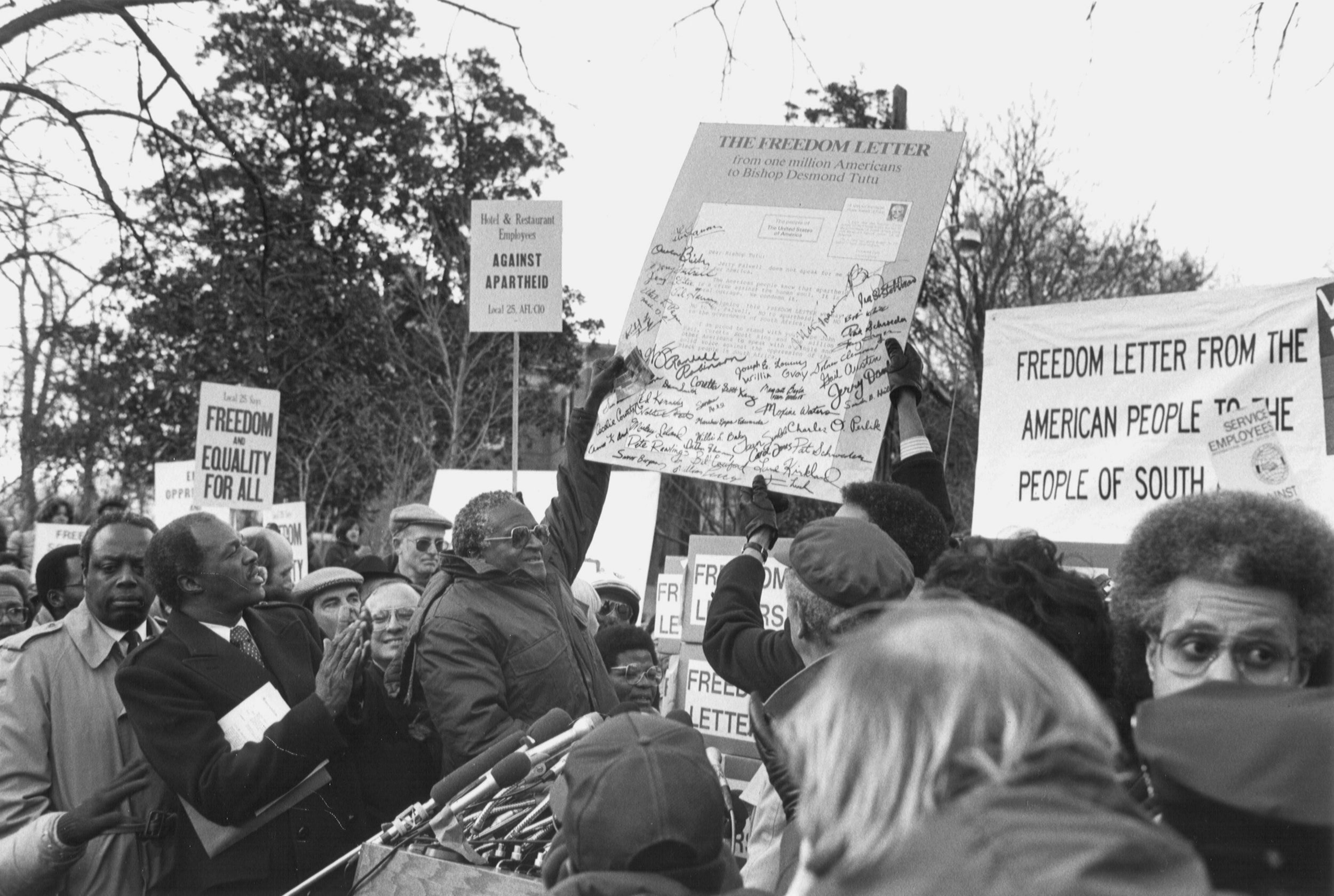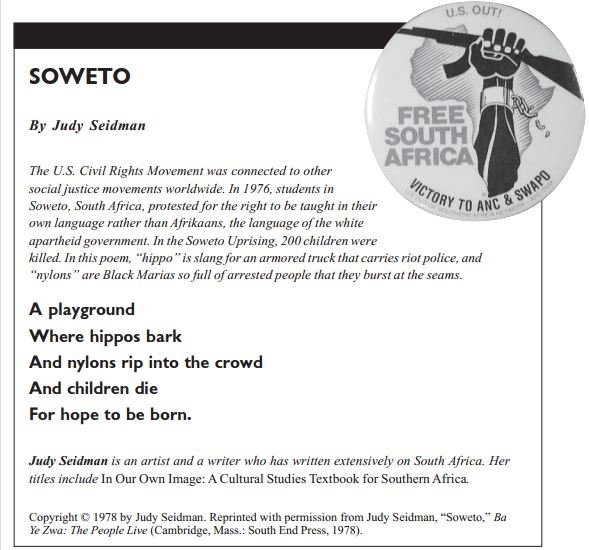Movers and Movements: Fighting for Social Justice in South Africa
Lesson by Brenda Randolph
By studying the lives of courageous people who have worked for social justice, students can learn more than history. They can learn how to face challenges, where to gather strength to face adversity, how to relate to other people, and how to deal with defeat. The many individuals who struggled against apartheid in South Africa live on as exemplars of extraordinary courage.
During this study, it is important to remember that the anti-apartheid struggle was more than a civil rights movement. It was a struggle by the majority population to regain control of the country’s economic resources and of its legal, political, and social institutions so that they served the many, not the few.
Bishop Desmond Tutu acknowledges receipt of more than 1,000,000 freedom letters on January 8, 1986 outside the South African Embassy in Washington, D.C. Photo © Rick Reinhard.
Objectives
Students will understand that the freedom struggle in South Africa was a collective effort involving multiple strategies.
Students will be able to identify major leaders in the anti-apartheid struggle, thereby seeing the work of the familiar names, such as Nelson Mandela and Bishop Desmond Tutu, in the context of a larger movement.
Materials
Unsung Heroes Activity Materials including Unsung Heroes Names and Brief Bios, Unsung Heroes Clue Sheet, and Unsung Heroes Answer Sheet.
Biographies of South Africans of note at SAHistoryOnline.
Instructions
This lesson begins with an Unsung Heroes Activity to introduce students to South African social justice activists. This is followed by an opportunity for students to learn more about the Unsung Hero whose character they represented.
PREPARATION
Name Badges
Use the names and information on the Name Badge Sheets to create student name badges. Cut and paste the information about the activist on the back of the badge. Write the name of the activist on the front of the badge. If you wish, you can also paste a picture of the activist under the name. (Pictures of most of the people described are available at www.sahistory.org.)
To prepare the name badges for the students to wear, slip each badge into a plastic name-badge holder. An alternative is to paste the name badges onto index cards, punch a hole in the cards, draw yarn through the hole, and have students wear necklace style. If there are more than 24 students, you may duplicate name badges for the additional students. If there are fewer than 24 students, you may give some students more than one name badge.
Handouts
Make a photocopy of the Unsung Heroes Clue Sheet for each student.
Post for Students to See
Post the instructions below on a smart board or flip chart where students can refer to them during the activity:
Unsung Heroes—Directions
You are responsible for completing your clue sheet by asking your classmate questions.
You must also respond to people who are trying to figure out who you are.
You can give only yes or no answers when asked about your identity.
Move around the classroom, read a clue to a person, and ask if the clue matches the person’s identity.
Each time you identify a person of courage, write his or her name in the blank next to the clue on your Unsung Heroes Clue Sheet.
Hand your Clue Sheet to the teacher when you are finished.
Implementation
Day One
Tell students that the purpose of Unsung Heroes is to identify and learn about a courageous person from a particular country.
Give each student a name badge and the Unsung Heroes Clue Sheet.
Explain that each class member has been given the name of a courageous person who fought against racism, injustice, and oppression in a particular country. Students are to keep the descriptions of their characters to themselves.
After distributing name badges, encourage students to read carefully and memorize the name of the person on their badge. (Students may want to write phonetic spellings to help with pronunciation.) Allow students quiet time to memorize the name.
Then have students memorize important facts about the person’s life from the back of the card.
Tell students that if they have questions about any words in the description on the back of the card, they should check with you privately during the activity so that they do not reveal their character’s identity to the group.
Review the directions (on the smartboard or flipchart) with the students.
Model the activity with a student. Ask a question about the student’s identity, and interrupt if the student answers with anything but a yes or no.
Ask the students if they have any questions about the instructions. If not, tell them to put on their name badges and begin.
When most of the students have finished or there are only ten minutes left in the class period (whichever comes first), end the activity.
Ask students to take their seats, and hand back the clue sheets to students who have turned them in already. Share the correct answers from the teacher answer sheet.
Ask them to share some reflections about the activity. You can prompt the discussion with questions such as: What did you learn that surprised you? What did you know already? What new information did you learn?
Close by explaining that the next time you meet, students will go learn more about their characters.
Day Two
Students can create a list of questions of what they would like to know about the South African unsung hero they represented.
Students can use the South Africa History Online biographies database and other resources to find the answers to those questions and more.
The teacher can identify a format for the students to document and share what they have learned.
Once the students have learned more about their unsung hero, the teacher and students can discuss and answer the following question
What qualities do social justice activists possess?
What were the issues and forms of repression addressed by activists in South Africa?
How did social justice activists from South Africa demonstrate their courage? Name various ways.
Identify sources of inspiration, skills, organizing strategies, and experiences of activists in South Africa.
Compare the list you made above to the sources of inspiration, experiences, skills, organizing strategies, and experiences of civil rights activists in the United States. Make a list of similarities. Then make a list of differences.
Additional Reading
The poem below by Judy Seidman is a provocative prompt for discussion.
The Unsung Heroes activity was adapted from a lesson by Bill Bigelow, published in Rethinking Schools, vol. 15, no. 1 (Fall 2000) and available online at the Zinn Education Project.


